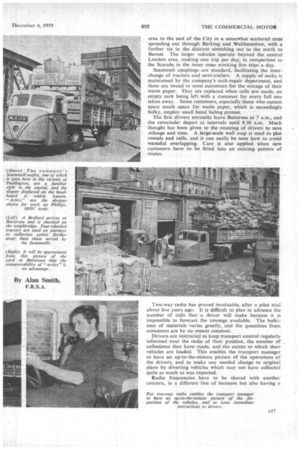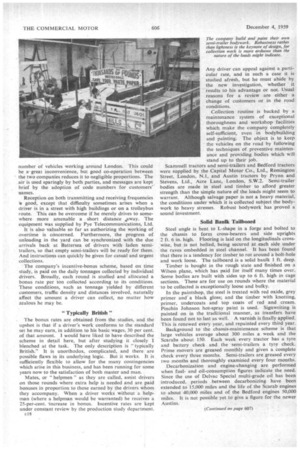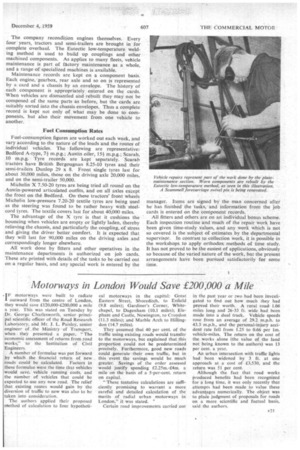DRIVING FOR TONNAGE ON THREE FRONTS
Page 60

Page 61

Page 62

Page 65

If you've noticed an error in this article please click here to report it so we can fix it.
Big London Salvage-paper Merchants Boost Transportivity by Rationalizing Routes, ,Paying Incentive Bonuses and Employing Two-way Radio
Most of the baled paper is carried by barge to board and paper mills, but sometimes road transport is employed. The barges are operated and maintained by a subsidiary concern. Road transport's role is chiefly the collection of the paper rather than its distribution from Battersea, and the fleet is almost wholly articulated.
There are 81 Scamn-iell semi-trailers and 38 tractors, of
whicht4 are Scarabs, nine Bedford A-types and live Austin 5.1-litre oilers. Three 'further Scammell tractors are used
within the yard at Battersea for shunting. A Bedford 2-3-ton rigid vehicle is also employed on internal duties, but can be used for collections at busy times,. • A Willys Jeep serves as a general runabout. All. the Scamrnell tractors are petrol models, but conversion to oil is being
started. It is already established policy to change over to Austin oilers in the four-wheeled tractor class.
• Articulated vehicles are favoured because the prime movers can be kept earning their keep while paper is being unloaded in the yard. Another advantage is that, where big customers are concerned, semi-trailer shuttle services can be worked.
Paper is collected chiefly from factories, business and printing houses, stores and other commercial establishments. About three-quarters of the work is done on regular contract, with the remainder casual from day to day. The buying manager works in close liaison with the transport manager, so that collections can be co-ordinated, in which respect the hard core of regular tonnage allows the fleet's operations to be planned in advance to a fairly great extent.
Collections vary in frequency according to the amounts of paper which customers have to offer and their individual requirements. Between 200 and 300 customers receive a daily call, 300-400 twice weekly, 150-200 weekly and
The company are replacing their petrol-engined four-wheeled tractors with Austin 5.1-litre forwardcontrol oilers. This load is of baled paper from a big customer.
area to the east of the City in a somewhat scattered zone spreading out through Barking and Walthamstow, with a further six in the districts stretching out to the north to Barnet. The larger vehicles operate beyond the central London area, making one trip per day, in comparison to the Scarabs in the inner zone working five trips a day.
Scammell couplings are standard, facilitating the interchange of tractors and semi-trailers. A supply of sacks is maintained by the company's sack-repair department, and these are issued to most customers for the storage of their waste paper. They are replaced when calls are made, an empty sack being left with a customer for every full one taken away. Some customers, especially those who cannot spare much space for waste paper, which is exceedingly bulky, employ small hand baling presses.
The first drivers normally leave Battersea at 7 a.m., and the remainder depart at intervals until 8.30 a.m. Much thought has been given to the routeing of drivers to save mileage and time. A large-scale wall map is used to plot rounds and calls, and it can easily be seen how to avoid wasteful overlapping. Care is also' applied when new customers have to be fitted into an existing pattern of routes.
Two-way radio has proved invaluable, after a pilot trial about five years ago. It is difficult to plan in advance the number of calls that a driver will make because it is impossible to forecast the tonnage available. The bulkiness of materials varies greatly, and the quantities from customers are by no means constant.
Drivers are instructed to keep transport control regularly informed over the radio of their position, the number of collections they have made, and the extent to which their vehicles are loaded. This enables the transport manager to have an up-to-the-minute picture of the operations of the drivers, and to make any needed change to original plans by diverting vehicles which may not have collected quite as much as was expected, Radio frequencies have to be shared with another concern, in a different line of business but also having a number of vehicles working around London. This could be agreat inconvenience, but good co-operation between the two companies reduces it to negligible proportions. The air is used sparingly by both parties, and messages are kept brief by the adoption of code numbers for customers' names.
Reception on both transmitting and receiving frequencies '‘s good, except that difficulty sometimes arises when a driver is in a street with high buildings or on a trolleybus route. This can be overcome if he merely drives to somewhere more amenable a short distance away. The equipment was supplied by Pye Telecommunications, Ltd.
It is also valuable so far as authorizing the working of overtime is concerned. Furthermore, the progress of unloading in the yard can be synchronized with the due arrivals back at Battersea of drivers with laden semitrailers, so that empty semi-trailers will be ready for them. And instructions can quickly be given for casual and urgent collections.
The company's incentive-bonus scheme, based on time study, is paid on the daily tonnages collected by individual drivers. Broadly, each round is studied and allocated a bonus rate per ton collected according to its conditions. These conditions, such as tonnage yielded by different customers, traffic density and distances involved, naturally affect the amount a driver can collect, no matter how zealous he may be.
"Typically British"
The bonus rates are obtained from the studies, and the upshot is that if a driver's work conforms to the standard set he may earn, in addition to his basic wages, 30 per cent. of that amount. I would have liked to have described the scheme in detail here, but after studying it closely I blenched at the •task. The only description is "typically British." It is unorthodox, complicated, and there are possible flaws in its underlying logic. But it works. It is sufficiently flexible to allow for the many contingencies which arise in this business, and has been running for some years now to the satisfaction of both master and man.
Mates, or " helpmen " as they are called, assist drivers on those rounds where extra help is needed and are paid bonuses in proportion to those earned by the drivers whom they accompany. When a driver works without a helpman (where a helpman would be warranted) he receives a 25-per-cent. increase in bonus. Incentive rates are kept under constant review by the production study department.
E I 8
The company build and paint their own semi-trailer bodywork. Robustness rather than lightness is the keynote of design, for collection work is more arduous than the nature of the loads might indicate.
Any driver can appeal against a particular rate, and in such a case it is studied afresh, but he must abide by the new investigation, whether it results to his advantage or not. Usual reasons for a review are either a change of customers or in the road conditions.
Collection routine is backed by a maintenance system of exceptional thoroughness and workshop facilities which make the company completely self-sufficient, even in bodybuilding and painting. The object is to keep the vehicles on the road by following the techniques of preventive maintenance and providing bodies which will stand up to their job.
Scammell tractors and semi-trailers and Bedford tractors were supplied by the Capital Motor Co., Ltd., Remington , Street, London, N.I, and Austin tractors by Prynn and Stevens, Ltd., Acre Lane, London, S.W.2. Semi-trailer bodies are made in steel and timber to afford greater strength than the simple nature of the loads might seem to warrant. Although salvage paper is not a heavy material, the conditions under which it is collected subject the bodywork to heavy stresses. Robust bodywork has proved a sound investment.
Solid Baulk Tailboard
Steel angle is bent to L-shape in a forge and bolted to the chassis to form cross-bearers and side uprights 2 ft. 6 in. high. Flooring is laid on the longitudinals crosswise, but is not bolted, being secured at each side under the raves embedded in steel channel. It has been found that there is a tendency for timber to rot around a bolt-hole and work loose. The tailboard is a solid baulk 1 ft. deep.
Timber is bought in the rough state and finished on a Wilson plane, which has paid for itself many times over. Some bodies are built with sides up to 6 ft. high in cage sections. These are for use on rounds where the material to be collected is exceptionally loose and bulky.
In the paintshop, the steel is treated with red oxide, grey primer and' a black gloss; and the timber with knotting, primer, undercoats and top coats of red and cream. Pinchin Johnson hot-spray paint is used. Signwriting is painted on in the traditional manner, as transfers have been found not to last as well. A varnish is finally applied. This is renewed every year, and repainted every third year.
Background to the chassis-maintenance scheme is that large vehicles average about 300 miles a week and the Scarabs about 150. Each week every tractor has a tyre and battery check and the semi-trailers a tyre check. Prime movers are greased monthly and given a complete check every three months. Semi-trailers are greased every two months and thoroughly examined every four months.
Decarbonization and engine-changing are performed when fueland oil-consumption figures indicate the need. Since the use of Delvac Special multi-grade oil has been introduced, periods between decarbonizing have been extended to 15,000 miles and the life of the Scarab engines to about 40,000 miles and of the Bedford engines 50,000 miles. It is not possible yet to give a figure for the newer Austins. The company recondition engines themselves. Every four• years, tractors and semi-trailers are brought in for complete overhaul. The Eutectic low-temperature welding method is used to build up couplings and other machined components. As applies to many fleets, vehicle maintenance is part of factory maintenance as a whole, and a range of specialized machines is available.
Maintenance records are kept on a component basis. Each engine, gearbox, rear axle and so on is represented by a card and a chassis by an envelope. The history of each component is appropriately entered on the cards. When vehicles are dismantled and rebuilt they may not be composed of the same parts as before, but the cards are suitably sorted into the chassis envelopes. Thus a complete record is kept not only of what may be done to components, but also their movement from one vehicle to another.
Fuel Consumption Rates
Fuel-consumption figures are worked out each week, and vary according to•the nature of the loads and the routes of individual vehicles. The • following are representative: Bedford A-type, 74m.p.g.; Austin oiler, 15+ m.p.g.; Scarab, 10 m.p.g. Tyre records are kept separately. Scarab tractors have British Bergougnan 8.25-10 tyres and their semi-trailers Dunlop 29 x 8. Front single tyres last for about 30,000 miles, those on the driving axle 20,000 miles, and on the semi-trailer 50,000.
Michelin X 7.50-20 tyres are being tried all round on the Austin-powered articulated outfits, and on all axles except the front on the Bedford. On these tractors' front wheels Michelin low-pressure 7.20-20 textile tyres are being used as the steering was found to be rather heavy with steelcord tyres. The textile covers last for about 40;000 miles.
The advantage of the X tyre is that it cushions the bouncing when vehicles are empty or lightly laden, thereby relieving the chassis, and particularly the coupling, of stress and giving the driver better comfort. It is expected that they will last for 90,000 miles on the driving axles and correspondingly longer elsewhere.
All work done by fitters and other operatives in the maintenance departments is authorized on job cards. These are printed with details of the tasks to be carried out on ,a regular basis, and any special work is entered by the manager. Items are signed by the man concerned after he has finished the tasks, and information from the job
cards is entered on the coniponent records.
All fitters and others are on an individual bonus scheme.
Each inspection routine and much of the repair work have been given time-study values, and any work which is not so covered is the subject of estimates by the departmental supervisor. In contrast to collection work, it is possible in the workshops to apply orthodox methods of time study. It has not proved to be the easiest of applications, obviously so because of the varied nature of the work, but the present arrangements have been pursued satisfactorily for some Lime.
























































































































